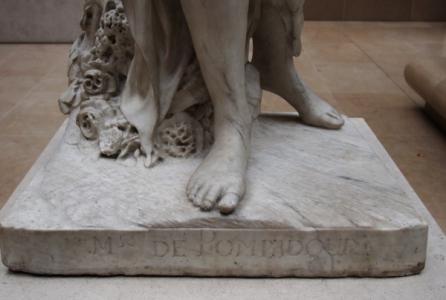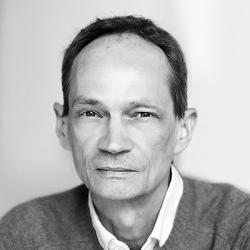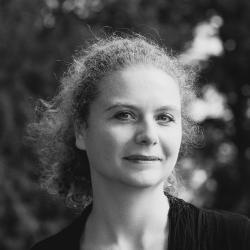Signum and Simulacrum
Signum and Simulacrum
Traces, Indices and Inscriptions in the Marble of Eighteenth-Century French Sculpture: Interpretive Space – Photographic Gaze – Art Historical Context
In Art and its Objects, Richard Wollheim designated the question of how we perceive sculpture as the most difficult problem and “loose end” in the philosophy of perception.1 Malcolm Baker recently took up the problem and examined the simultaneous perception of marble sculpture as representation and material substance, concluding his contribution with Wollheim’s above-mentioned remark.2 Too many loose ends still need to be picked up. Signum and Simulacrum deals with selected eighteenth-century marble sculptures under the premise of perception and emphasizes traces and indices that draw attention to their material surfaces. Three perspectives are thereby opened up: the interpretive space of the focused “close-up view”; the photographic gaze; and art-historical classification, which includes the considered sculptural details within a semiotic analysis that also takes into account the technical process of selection, processing, and production of the work.
The Interpretive Space of the “Close-Up View”
The project reflects on a positon of reception, the spatial proximity of which leads to a specific constellation of perception, as with an experience of movement and looking. We already know such a perspective of observation as an intentional stance from the time of the emergence of the works in question, as shown in a drawing by Gabriel Saint-Aubin for an exhibition at the Salon de Paris in 1767. The audience comes very close to the sculptures, which are presented on tables and pedestals. The question of viewing from a distance or from up-close is of course older (Titian), but in the eighteenth century it entered a discourse concerning the adequate viewing posture, for example with the opposition between quiet contemplation and extroverted art talk (Chodowiecki, Winckelmann). Since Félibien’s promenades in the Park of Versailles, the installation site, using the example of the garden sculpture, has raised the question of the appropriate position for viewing (Herder).
Viewed close-up, the “big picture” recedes in perception, with the manual working and the material textures of the marble becoming the center of attention. But what avenues of interpretation are afforded by notches and bores, by veins, cracks, and even “errors” in the material? How does the shaped stone become a flower or a toenail in our perception, i.e. an illusion? Wolfram Pichler formulated this question in art-historical terms and got to the heart of it: How to enter image-space?3 Though he directed this question toward the mental image, the imagination, and visual representation and toward the two-dimensional image as a stimulus, it can also be related to a material context and a three-dimensional object – knowing full well that Wollheim already led us into complex terrain. How do the material forms come about, the forms that seduce us into associations that are diverse, initially vague, and largely quite individual? And – in methodological terms – to what extent might an analysis that concerns itself with the processes by which forms are developed be made fruitful as an art-historical approach in pursuit of answers?
The Photographic Gaze
In order to transfer analytic knowledge from a direct encounter into a scientific discourse or to develop a more comprehensive art-historical argument, photographs are required. Theses about sculpture are often formulated purely in interaction with images and subsequently verified on site with the originals. The role of photographic reproduction, which superimposes the real sculpture and the unmediated perception of the images in the publication medium, thus becomes a decisive factor when thinking about sculpture. Along the spectrum between objectifying documentary photography and subjective expression, the project Signum and Simulacrum takes a clear position in favor of accepting a subjective photographic gaze. The decision to incorporate individual and closer observation of sculpture is designed as an experiment and is to be measured against the primary question of the extent to which this perspective offers an added analytic value. However, this method must be situated in the cultural-historical context of sculpture photography.4 In particular, the history of archeology as a discipline has already dealt with the question of the preemptive (invalid) interpretation via the photographic image.5 Out of art-historical interest, for example, Clarence Kennedy consciously worked with photographic means in his studies of Greek and Florentine sculpture at the beginning of the twentieth century.6
For Ulrich Middeldorf, Kennedy’s photographs express the sculptural quality of the works. He anchored this in the formal categories of “structure, design, modelling and textures.”7 From the point of view of the history of art history as a discipline, formalism established itself at the beginning of the twentieth century in the context of new reproduction technologies (for example, in Heinrich Wölfflin’s positing of the fundamental concepts of art history, Munich 1915). To what extent is the analysis of form in research on sculpture linked to a photograph, one that reproduces the sculptures from up-close and without regard for the wholeness of the outline?
But the question of the potential for reflection that the photographic image opens up for art-historical analysis arises not only in relation to the historiography of the subject. Even against the current backdrop of the Digital Humanities’ seemingly infinite, boundless, and trans-local infrastructure through virtual and online image databases, spatial reproductions in 3D printing, and computer-aided, image-generating, dynamic procedures for the representation of the most complex contexts, it is crucial to consistently tie visual reproductions back to the depicted object and keep semiotic loops in view. Technological development has increased the available quantity and comparability of sculptures, which are kept in a wide variety of locations, and thus massively expands the horizon of thought in these dimensions. Yet there remains the challenge of dealing with the three-dimensionality, the material presence, and the site-specificity of this artform. What can a “subjective” photography – incorporating unconventional perspectives, social confrontations, atmospheres, and the dramaturgy of light and shadow – contribute to fostering art-historical knowledge?
Art-Historical Classification of Traces and Indices
In reflecting on the space of interpretation and the photographic gaze, Signum and Simulacrum also considers the art-historical classification of the subject. Hans Körner demonstrated the relevance of an in-depth structural analysis of sculptural practice.8 He described the sculptural interest in the surface texture evoking the “epidermis” in stone sculpture made in France from the late seventeenth to the early nineteenth century and mapped out an “overlay” between transcendence and the accentuation of the “stone-ness of stone.”9 For example, the fine scratches on the polished surface of Jean-Baptiste Pigalles Voltaire nu (1776, Musée du Louvre, Paris) could be a subtle, self-referential indication of the technical process. Observation from up-close and the photographic equivalent à la Kennedy reveal not only formal qualities but also artisanal-artistic markings and material coincidences in the transformation process from stone block to image-object.
This section reflects striking details, special techniques, and representational conventions. Based on these observations, subject areas can be identified that set the sculptural work into an art-historical as well as a social- and material-historical framework. These include, for example, the hierarchical relationship between sculpture theory and sculptural practice; the working conditions of the sculptors between the workshop and the art academy; and the material-aesthetic estimation of white marble as an exclusive and at the same time conventional material for sculpture.
- Richard Wollheim, Art and its Objects, 2. Edition, with six supplementary essays, Cambridge University Press 1980, 224 und 226.
- Malcolm Baker, Sculpture and representation. Apprehending marble portrait sculpture in the eighteenth century, Sculpture Journal (2021), 30, (2), 123–137.
- Wolfram Pichler, How to enter image-space, in: RES, 71/72 (2019), 325-332.
- Geraldine A. Johnson, „In Consequence of their whiteness.” Photographing Marble Sculpture from Talbot to today, in: J. Nicholas Napoli and William Tronzo, Radical Marble. Architectural Innovation from Antiquity to the Present, London, New York, 2018, 107–132.
- Siehe Belichtete Vergangenheit. Archäologie und Fotografie, Fotogeschichte, Nr. 144 der Beiträge zur Geschichte und Ästhetik der Fotografie 144 (2017), hrsg. von Babett Forster sowie Franu Schubert u. Susanne Grunauer-von Hoerschelmann, Archäologie und Photographie. Fünfzig Beispiele zur Geschichte und Methode, Mainz 1978, ferner: Philippe Collet, „La photographie et l'archéologie : des chemins inverses“, in: Bulletin de correspondance hellénique 120,1 (1996), S. 325-344.
- https://www.getty.edu/art/collection/artists/1345/clarence-kennedy-american-1892-1972/
- Ulrich Middeldorf, Clarence Kennedy 1892–1972, Art Journal, 32:3 (1973), 372.
- Hans Körner, Die Epidermis der Statue. Oberflächen der Skulptur vom späten 17. bis zum frühen 19. Jahrhundert, in: Daniela Bohde und Mechthild Fend (Hg.), Weder Haut noch Fleisch. Das Inkarnat in der Kunstgeschichte, Berlin 2007, 105–132. Malcolm Baker, Hans Körner, Erika Naginski und Guilhem Scherf, Les Études sur la Sculpture. Le XVIIIe Siècle en Questions, in: Perspective, 3, (3) (2010/2011), 419–433.
- Körner: Die Epidermis der Statue, 109.
Researcher







